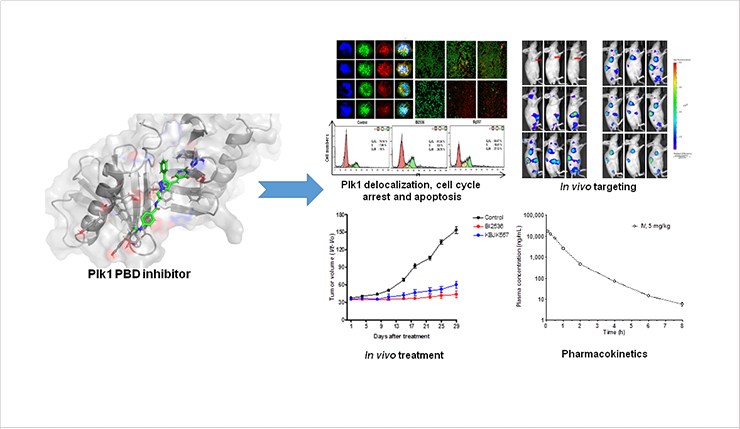Representative Research Publications
Discovery of a small-molecular anticancer agent by inhibition of Polo-like kinase1 2020 > Representative Research Publications > Research Results Home
Discovery of a small-molecular anticancer agent by inhibition of Polo-like kinase1
- J. Med. Chem. / December 2020
- Pethiah Gunaseka(First author), Min Su Lim(First author), Eun Kyoung Ryu(Corresponding author), Jeong Kyu Bang(Corresponding author)
Study Summary
Polo-like kinase 1 (Plk1) plays a key role in mitosis and has been identified as an attractive anti-cancer drug target for a wide spectrum of cancers in humans. Plk1 consists of two drug targeting sites, namely N-terminal kinase domain (KD) and C-terminal polo-box domain (PBD). KD-targeting inhibitors are associated with severe side effects likely due to an intolerable level of cross-reactivity with other related kinases, including Plk2 and Plk3. However, the C-terminal PBD, a unique protein–protein interaction domain of the Plk subfamily, offers an inherent advantage in terms of selectivity, and PBD-dependent subcellular location is critical for the mitotic functions of Plk1. Thus, specific inhibition of the function of Plk1 PBD is considered as an attractive therapeutic strategy for treating cancer, as it would trigger the G2/M cell cycle arrest and subsequent apoptosis in tumor cells.
Although minimal peptide, PLHSpT, and its derivatives were reported as novel peptide-based Plk1 PBD inhibitors, which posses severe drawbacks, such as proteolytic instability and poor cell permeability. To overcome the disadvantages of peptide inhibitors, few small molecular inhibitors were reported and investigated in vivo. However, whether they exhibit anti-tumorigenic activities has not been reported. Moreover, these inhibitors were not identified through an extensive structure-activity relationship (SAR) study.
To overcome above mentioned disadvantages, in this study, we discovered a first pyrazolopyrimidine-fused small molecule, KBJK557 as a new chemical scaffold against Plk1 PBD, makes several significant advances over other reported Plk1 PBD inhibitors. Firstly, the most active compound, KBJK557, obtained through extensive SAR studies that involve two phases with nineteen newly synthesized pyrazolopyrimidine compounds. The most potent compound, KBJK557 displayed a significant level of Plk1 PBD selectivity with enhanced cell permeability.
Secondly, at the cellular level, KBJK557 is capable of effectively delocalizing Plk1 from its subcellular localization sites and consequently inducing mitotic arrest and apoptotic cell death in cancer cells. Thus our study demonstrates that specifically inhibiting PBD-dependent interaction is sufficient to disrupt Plk1 function.
Thirdly, most of the conventional chemotherapeutic drugs possess severe setbacks in distinguishing the cancer cells from normal cells. Thus, identifying a cancer drug with considerable selectivity towards the cancer cells remains the greatest challenge in the field of cancer therapy. In our study we showed that, in an optical imaging study, Cy5-conjugated KBJK557 significantly accumulated in tumors, but not their surrounding normal tissues, proving selectivity towards cancer cells.
Fourthly, with encouraging tumor-targeting selectivity results, we investigated the anti-tumorigenic activities of KBJK557 by intravenously injecting KBJK557 in a mouse xenograft model. Interestingly, KBJK557 displayed a significant effect in inhibiting cancer growth in a mouse xenograft model with a low dosage level.
Finally, to support the in vivo activity of KBJK557, we investigated the pharmacokinetic profiles of KBJK557. Partition coefficients suggested the systemic exposure of KBJK557 in the blood, thereby distributing to the highly perfused organs, such as liver, kidney, heart, and spleen after intravenous administration in mouse with an intermediate level of clearance (CL, 0.43 L/hr/kg), half-life (t1/2, 7.73 hr), and sufficient systemic exposure (AUC, 11.5 μg*hr/mL) in the body
 Figure Describes the in vitro and in vivo and pharmacokinetics of KBJK557
Figure Describes the in vitro and in vivo and pharmacokinetics of KBJK557
This is the first study reporting a small-molecule scaffold against Plk1 PBD that exhibits anti-tumor activities in a mouse xenograft model with significant pharmacokinetic profiles. KBJK557 appears to have a great potential to be a model for designing anti-cancer drugs that show selective cancer-targeting ability by targeting Plk1 PBD.



